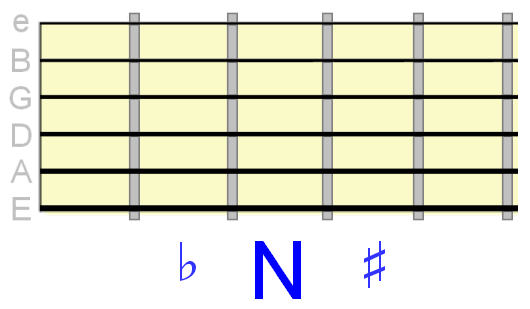Step by step process for learning the fretboard notes
First, we need to understand what notes are and how they are written.
In their most basic form, notes are the pitch of a sound. For example, play any string on your guitar at any fret and it will sound a note.
The three note types
There are three types of note - natural, flat and sharp.For example, an A natural note would simply be written as A.
An A flat note would typically be written as A♭ or Ab.
An A sharp note would typically be written as A♯ or A#.
If we were to visualise the flat and sharp notes in relation to the natural note, we would see the natural in the middle with the flat on the left and sharp on the right...
A♭
A
A♯
So think of "flat" as one pitch/note "down" and sharp as one note "up" from a natural note.
On the fretboard, each fret represents a note, so the above relationship would appear as follows, with N being the natural note (on any string)...

The musical alphabet
| A | A♯ B♭ |
B | C | C♯ D♭ |
D | D♯ E♭ |
E | F | F♯ G♭ |
G | G♯ A♭ |
The note after A♭/G♯ will be the note A - the sequence repeats every 12 notes. This 12 note sequence is known as the chromatic or 12 tone scale.
The pitches which have sharp and flat notes are known as enharmonic. A♯ and Bb are the same pitch (they are enharmonic), as are C♯ and D♭ etc. Which one we use depends on a few factors and you will learn what these are as you progress.
Now, you'll notice that some notes are not separated by sharps or flats - namely, B and C, E and F. This means that a B♯ would in fact be C. C♭ would be B. E♯ would in fact be F.
Contrary to common knowledge, there are instances where you would write the notes C and F as B♯ and E♯ respectively, but we'll come to all that later. All you need to know now is that the above is the natural sequence of notes to memorize when we apply it to the guitar fretboard.
On the guitar fretboard

- The open E string gives us a low E note. The 12th fret E is the same note, but an octave higher in pitch.
- F note at the 1st fret
- G note at the 3rd fret
- A note at the 5th fret
- B note at the 7th fret
- C note at the 8th fret
- D note at the 10th fret
All we need to do is fill in the gaps with the sharps/flats from the table earlier. Again, don't worry about whether to use a sharp or flat at this stage, just memorise the positions of these enharmonic notes...

- F sharp / G flat at the 2nd fret
- G sharp / A flat at the 4th fret
- A sharp / B flat at the 6th fret
- C sharp / D flat at the 9th fret
- D sharp / E flat at the 11th fret

- A note on the open string. The 12th fret A is an octave higher.
- B note at the 2nd fret
- C note at the 3rd fret
- D note at the 5th fret
- E note at the 7th fret
- F note at the 8th fret
- G note at the 10th fret

- A sharp / B flat at the 1st fret
- C sharp / D flat at the 4th fret
- D sharp / E flat at the 6th fret
- F sharp / G flat at the 9th fret
- G sharp / A flat at the 11th fret
So that just leaves the D, G and B strings.
The below diagram shows the completed fretboard with the fret numbers beneath (O is for open string).

Help with fretboard note memorisation
Source article: http://www.fretjam.com









